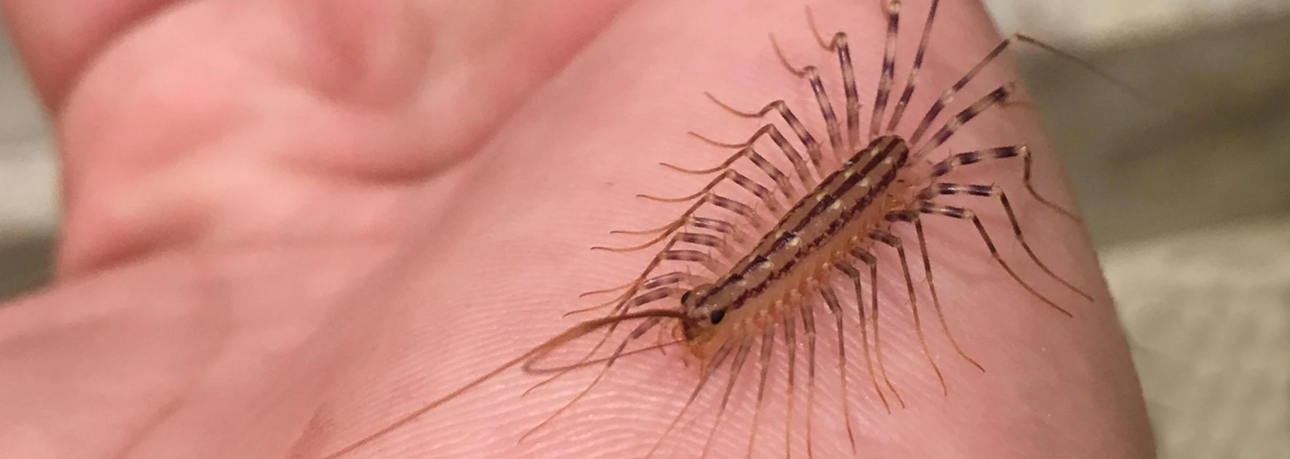Centipede & Millipede Pest Control Services
In Orange County, the most common species encountered is the house centipede. While their presence can be unsettling, understanding their behavior, diet, and habitat can help in effectively managing and preventing infestations.

Identification Characteristics
House centipedes are easily recognized by their long, delicate legs and swift movements. They have elongated, flattened bodies with 15 pairs of legs, the last pair being significantly longer in adult females. Their bodies are typically yellowish-gray with dark stripes running down their length. Unlike many other centipede species, house centipedes have well-developed eyes, which contribute to their rapid and erratic movements when disturbed.
Life Cycle
House centipedes have relatively long lifespans compared to other arthropods, living up to 3–7 years. They undergo incomplete metamorphosis, meaning they hatch from eggs into juvenile forms that resemble smaller versions of adults. Over time, they molt and gain additional legs with each stage. A female house centipede can lay anywhere from 35 to 150 eggs in damp, hidden locations, ensuring a steady population when conditions are favorable.
Diet and Habitat
Centipedes are natural predators that help control populations of other pests such as cockroaches, termites, ants, and silverfish. They use their sharp, venomous fangs to immobilize prey before consuming them. Because they rely on moisture to survive, centipedes are often found in damp areas such as basements, bathrooms, crawl spaces, and under rocks or logs outdoors. Their preference for humid environments makes Orange County’s coastal and inland areas ideal habitats, particularly in homes with excess moisture.
At Wipe Out Pest Control, we provide house centipede control for homes across Orange County, including Placentia, Huntington Beach, Anaheim, Yorba Linda, and Fullerton. Our team understands how centipedes behave in damp, coastal Southern California conditions. Whether they’re appearing in your bathroom or crawlspace, our targeted, moisture-aware treatments offer safe, lasting protection from these creepy intruders.
Key Takeaways and Control Methods
While house centipedes are beneficial in reducing other insect populations, most homeowners prefer not to share their space with these speedy predators. Here are some effective ways to manage and prevent centipede infestations:
Reduce Moisture
Fix leaks, use dehumidifiers, and improve ventilation to eliminate the damp conditions centipedes thrive in.
Eliminate Food Sources
Since centipedes feed on other insects, regular pest control treatments can help reduce their prey and, in turn, their presence.
Seal Entry Points
Close gaps around doors, windows, and foundation cracks to prevent centipedes from entering your home.
Declutter and Clean
Remove piles of debris, wood, and organic matter around your home that may serve as shelter.
Targeted Treatments
Professional pest control applications in key areas can help reduce centipede populations and prevent future issues.
Reduce Moisture
Fix leaks, use dehumidifiers, and improve ventilation to eliminate the damp conditions centipedes thrive in.
Eliminate Food Sources
Since centipedes feed on other insects, regular pest control treatments can help reduce their prey and, in turn, their presence.
Seal Entry Points
Close gaps around doors, windows, and foundation cracks to prevent centipedes from entering your home.
Declutter and Clean
Remove piles of debris, wood, and organic matter around your home that may serve as shelter.
Targeted Treatments
Professional pest control applications in key areas can help reduce centipede populations and prevent future issues.
If centipedes are becoming a nuisance in your home, our maintenance plans will help manage their numbers and prevent recurring infestations. Our team specializes in effective, long-term solutions tailored to Orange County’s unique pest challenges. Contact us today to schedule an inspection and take back your home from unwanted creepy crawlies!
FAQS
Do house centipedes bite or cause harm?
House centipedes rarely bite and are not considered dangerous, though they can startle you with their appearance and speed.
What cities do you serve in Orange County?
We service Anaheim, Placentia, Yorba Linda, Huntington Beach, Fullerton, and other Orange County areas.
How do I prevent centipedes in my home?
Reduce humidity, seal gaps, and minimize their food sources (other pests). Regular pest treatments help keep them away.
Are your treatments safe for children and pets?
Yes. Our centipede control methods are eco-conscious and safe for use around your family and pets.
Do you offer one-time or ongoing pest control for centipedes?
Both. We offer single visits and ongoing pest management plans customized to your property’s needs.
our services
Simple Solutions To Complex Problems at an Affordable Rate

Residential
We offer a variety of plans custom fit for your needs! Whether its an endless trail of ants, or strange noises in the walls, we’ve got your pest control needs covered!

Commercial
We can stop pests from causing costly machinery repairs, fines, closures, and damage to your reputation!

rodents
Various species of rats and mice inhabit the Orange County area. Remove rodents from your home permanently with our exclusion services.

mosquito
We use the In2Care system to eliminate mosquitoes where they breed—protecting your family’s health and comfort.

